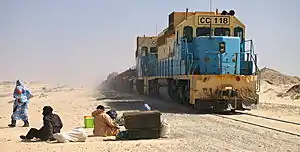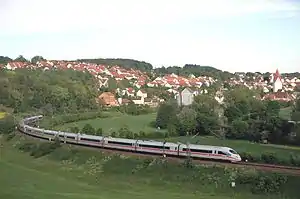Longest trains
The length of a train, including the longest trains, may be measured in number of wagons (for bulk loads such as coal and iron ore) or in metres for general freight. Train lengths and loads on electrified railways, especially lower voltage 3000 V DC and 1500 V DC, are limited by traction power considerations. Drawgear and couplings can be a limiting factor, tied in with curves, gradients and crossing loop lengths.

Conventional freight trains in India can average nearly 2.8 km (2800 m).[1] Freight trains with a total length of three or four times that average are possible with the advent of distributed power, or additional locomotive units between or behind long chains of freight cars (referred to as a "consist"). Additional locomotive units enable much longer, heavier loads without the increased risks of derailing that stem from the stress of pulling very long chains of train-cars around curves.
Bulk

- Australia
- Rio Tinto—29,500 tonnes of iron ore—2.4 km, three locomotives
- BHP iron ore train has typically 268 cars and a train weight of 43,000 tonnes carrying 24,200 tonnes of iron ore, 2.8 km long, two SD70ACe locomotives at the head of the train and two remote controlled SD70ACe locomotives as mid-train helpers[3]
- BHP used to run iron ore trains of 336 car length, 44,500 tonnes of iron ore, over 3 km long, six to eight locomotives including intermediate remote unit. This operation seems to have ceased since the trunk line was fully double tracked in May 2011.[4]
- The record-breaking ore train from the same company, 682 cars and 7,300 m long, once carried 82,000 metric tons of ore for a total weight of the train, largest in the world, of 99,734 tonnes. It was driven by eight locomotives distributed along its length to keep the coupling loads and curve performance controllable.[5]
- Leigh Creek coal—2.8 km, 161 wagons and 2 locomotives.[6][7]
- Cane tramway – 75 wagons (610 mm (2 ft) gauge)[8]
- Brazil
- Carajás Railway 1,600 mm (5 ft 3 in) gauge iron ore typically 330-car trains, each 3 km long.[9]
- VLI 1,600 mm (5 ft 3 in) Grain with 160 Hopper or 80 Hopper+72 FTTs (for pulp transport) about 3.2 km (2-mile) long[10]
- China
- Daqin Railway coal trains—20,000 t, 3.2 km, 210 wagons
- Mauritania—3 km[11]—iron ore from Zouérat—trains lurch violently when accelerating or braking
- India
- Indian Railways operated the longest train in India on 2 June 2020. The 'SheshNag' freight train was 2.8 km long had a total of 251 wagons.[12]
- The 'Super Anaconda' three-in-one freight service has 177 wagons and three electric locomotives with a 6000 HP capacity each.
- Indonesia (proposed)
- South Africa
- Sishen–Saldanha railway line ore trains on 1,067 mm (3 ft 6 in) – 4100 m[14]
General

- 5166 m – Mexico – The Kansas City Southern de Mexico operating between Laredo and San Luis Potosí.
- 4730 m – United States — The Kansas City Southern Railway regularly runs between Kansas City, MO and Shreveport, LA
- 4200 m – Canada – double-stack container trains reaching 4200 m are regularly operated by Canadian National Railway systemwide with distributed power diesel electric locomotives. General cargo trains are limited to 3700 m, and bulk trains are limited to 3000 m but up to 20,700 tons
- 3658 m – United States – Trains are limited by air brake capability. electronically controlled pneumatic braked (180 wagons) – AAR Standard S-4200.[15]
- 3500 m – India – The South-East Central Railways (SECR) zone operate freight train by amalgamating five rakes of goods trains as one unit of around 3.5 km. Named as ‘Vasuki’, it covered a distance of 224 km.
- 1800 m – Australia—Parkes–Perth–Adelaide–Darwin—(limited by 1800 m crossing loops)
- 1524 m – France – intermediate locomotive – trial[16]
- 1500 m – Australia—Adelaide–Melbourne–Sydney–Brisbane—(limited by 1500 m crossing loops; some loops to be extended to 1800 m)
- 1500 m – UIC standard double length train
- 1222 m – The Bangalore–Dharmavaram goods train (India)[17]—The train runs between Bangalore and Dharmavaram almost every day. There is no stop for this train, and there is no railway station on this route which can accommodate the whole train on a single track or platform. Indian Railways term this as increased vehicle length (IVL). This reduces the traffic in this single-lined region; two goods train attached back to back, each train is led by two diesel-electric locomotives.
- 1000 m
- The Netherlands–Germany—trial trains of this length[18]
- Saudi Arabia 1000 m double stack[19]
- 835 m — In Denmark and to Hamburg, Germany; 2 locomotives and 82 waggons.[20][21]
- 800 m — RVR in East Africa (Kenya–Uganda) to introduce longer trains, which needs longer crossing loops.
- 750& m – Normal for mainlines in several countries in Europe.
- 750 m – UIC standard single length train
- 400 m – New South Wales steam era, where lengths also limited by practical length of crossing loops mechanically operated from signal boxes.
Passenger

- Australia – The Ghan, running the 2,979 km from Adelaide to Darwin, was lengthened to 44 coaches totalling 1,096 m for nine weeks from May 2016.[22] More usually, both The Ghan and the Indian Pacific, which runs the 4,352 km from Perth to Sydney, average around 30 coaches, with a motorail wagon and two locomotives, totalling around 770 m in length.
- Canada – The Canadian transcontinental train may have 33 cars during peak season (May to September)
- China – Beijing–Shanghai high-speed railway Fuxing CR400AF–B and Fuxing CR400BF–B 17-car trainset 440 m
- Denmark – five ER ("IR4") electrical train sets combined – 380 m
- France – two TGV Atlantique trains combined – 476 m
- German Democratic Republic – up to 22 cars Berlin–Dresden (– Prague) ca. 500 m
- Germany – two ICE 3 trains combined – 402 m
- India – 24-coach trains are standard for most popular long-distance services, which translates to approximately 600 meters per train.
- Japan – Tōkaidō Shinkansen N700 16-car trainset 404 m
- Mauritania – the Mauritania Railway, one of top 10 longest trains in the world, up to 3 kilometres the often has passenger cars attached in the rear.
- Mongolia – up to 30 coaches on the Ulaanbataar – Zamiyn Ude train.
- Netherlands – up to 15 coaches (five 3-coach NS Intercity Materieel trains combined)[23] – 403 m
- Russia – two combined Sapsan trains – approx. 500 m
- Sweden – 17 coaches (26.7 m each plus two Rc locomotives at 15.4 m) – 484 m between Stockholm and Luleå. Sometimes charter trains are longer than that, e.g. 22 coaches, 530 m on 24–25 February 2012.[24]
- United Kingdom, Belgium, France, Netherlands – Eurostar / British Rail Class 374 (16-car electric multiple unit) – 400 m
- United States – Auto Train between Lorton, Virginia, and Sanford, Florida – up to 50 cars. 4 or 5 coaches, 1 lounge, 3 diners, 6 sleepers, one transition sleeper and up to 35 autoracks – approx. 1440 m
- United States – Ringling Bros. and Barnum & Bailey Circus trains – were the longest privately operated passenger trains in the world at nearly sixty cars each. Two trains, the Red unit and the Blue unit, toured the country in an overlapping two-year cycle. Each circus train consisted of around 40–45 passenger cars with dorm rooms for the circus performers and crews, four animal cars usually placed at the front of the train for a smoother ride, a dining car referred to as the "pie car", two generator cars to provide power to the train, two merchandise boxcars, and 15–20 flatcars carrying circus vehicles and containers. Ceased operations in 2017.
- USSR/Russia – 32 coaches – 846 m; total weight of 1,920 tonnes, using locomotive ChS7 or ChS8.[25]
Special test runs
(These are one-off to set records)
Bulk (ore, coal etc)
.svg.png.webp) BHP run on 21 June 2001, comprising 682 wagons and hauled by eight 6000 hp General Electric GE AC6000CW diesel-electric locomotives controlled by a single driver with a total length of 7.352 km on the 275 km iron ore railway to Port Hedland in Western Australia – total weight 99,734 tons on a 1,435mm gauge line.[26]
BHP run on 21 June 2001, comprising 682 wagons and hauled by eight 6000 hp General Electric GE AC6000CW diesel-electric locomotives controlled by a single driver with a total length of 7.352 km on the 275 km iron ore railway to Port Hedland in Western Australia – total weight 99,734 tons on a 1,435mm gauge line.[26] Sishen–Saldanha, South Africa. Run on 26–27 August 1989, comprising 660 wagons, 7.302 kilometres (4.537 mi) long and a total weight of 71 765 tons on a 1,067mm gauge line. The train comprised 16 locomotives (9 Class 9E 50 kV AC electric and 7 Class 37 diesel-electric).[27][28]
Sishen–Saldanha, South Africa. Run on 26–27 August 1989, comprising 660 wagons, 7.302 kilometres (4.537 mi) long and a total weight of 71 765 tons on a 1,067mm gauge line. The train comprised 16 locomotives (9 Class 9E 50 kV AC electric and 7 Class 37 diesel-electric).[27][28] Bulk coal train from Ekibastuz to the Urals, Soviet Union, 20 February 1986. The train consisted of 439 wagons and several diesel locomotives distributed along the train with a total mass of 43,400 tonnes and a total length of 6.5 kilometres (4.0 mi).[29]
Bulk coal train from Ekibastuz to the Urals, Soviet Union, 20 February 1986. The train consisted of 439 wagons and several diesel locomotives distributed along the train with a total mass of 43,400 tonnes and a total length of 6.5 kilometres (4.0 mi).[29] Norfolk & Western Railway unit coal train from Iaeger, West Virginia to Portsmouth, Ohio, 15 November 1967. The train consisted of 500 cars and six EMD SD45 diesel-electric locomotives distributed throughout the train for a total weight of 48,170 tons and total length of 6.5 kilometres (4.0 mi).[30]
Norfolk & Western Railway unit coal train from Iaeger, West Virginia to Portsmouth, Ohio, 15 November 1967. The train consisted of 500 cars and six EMD SD45 diesel-electric locomotives distributed throughout the train for a total weight of 48,170 tons and total length of 6.5 kilometres (4.0 mi).[30]
General cargo
 Union Pacific, United States. Run from 8–10 January 2010, consisting of 296 container cars and hauled by nine diesel-electric locomotive spread through the train with a total length of 18,000 feet (3.4 mi; 5.5 km), from a terminal in Texas to Los Angeles. Around 618 double-stacked containers were carried at speeds up to 70 mph/112 km/h. 14,059 t.[31][32]
Union Pacific, United States. Run from 8–10 January 2010, consisting of 296 container cars and hauled by nine diesel-electric locomotive spread through the train with a total length of 18,000 feet (3.4 mi; 5.5 km), from a terminal in Texas to Los Angeles. Around 618 double-stacked containers were carried at speeds up to 70 mph/112 km/h. 14,059 t.[31][32] BNSF, United States, 2010—12,832 feet (2.4303 mi; 3.911 km)[33]
BNSF, United States, 2010—12,832 feet (2.4303 mi; 3.911 km)[33]
Passenger
 Kijfhoek–Eindhoven, Netherlands. In 1989 the ' Nederlandse Spoorwegen' (NS/Dutch Railways) celebrated their 150th anniversary. On 19 February 1989, NS ran a test (some call it a publicity stunt) with what would become the longest passenger train in the world. The train was pulled by one 1500 V DC locomotive and had 60 passenger cars (1600 meters, 2600 ton), of which only the first 14 cars held actual passengers during the run.[34] Twenty years later, in 2009, Railz Miniworld repeated the stunt on a smaller scale, inside their exhibition in Rotterdam.[35]
Kijfhoek–Eindhoven, Netherlands. In 1989 the ' Nederlandse Spoorwegen' (NS/Dutch Railways) celebrated their 150th anniversary. On 19 February 1989, NS ran a test (some call it a publicity stunt) with what would become the longest passenger train in the world. The train was pulled by one 1500 V DC locomotive and had 60 passenger cars (1600 meters, 2600 ton), of which only the first 14 cars held actual passengers during the run.[34] Twenty years later, in 2009, Railz Miniworld repeated the stunt on a smaller scale, inside their exhibition in Rotterdam.[35].svg.png.webp) Ghent–Oostende, Belgium. On 27 April 1991, one electric locomotive and 70 passenger cars (totalling 1733 m and 2786 ton, excluding locomotive) held a charity run for the Belgian Cancer Fund, thereby exceeding the Dutch record.[34]
Ghent–Oostende, Belgium. On 27 April 1991, one electric locomotive and 70 passenger cars (totalling 1733 m and 2786 ton, excluding locomotive) held a charity run for the Belgian Cancer Fund, thereby exceeding the Dutch record.[34]
See also
- Distributed power—Where operational considerations or economics require it, trains can be made longer if intermediate locomotives are inserted in the train and remotely controlled from the leading locomotive.
- Heaviest trains
- High-speed rail
- Track gauge
- Extreme Trains on the History Channel 2009
- List of steepest gradients on adhesion railways
- International Heavy Haul Association
- Longest road trains
References
- Joiner, Stephen (11 February 2010). "Is Bigger Better? 'Monster' Trains vs Freight Trains". Popular Mechanics.
- According to count of visible cars in the pic and Google Earth imagery of 2011.
- According to count of visible cars in Google Earth imagery of April 2015.
- "BHP RGP5 Railway. Pilbara Region. Australia". Archived from the original on 3 August 2016. Retrieved 6 January 2016.
- "BHP breaks its own 'heaviest train' record". Railway Gazette International. Retrieved 7 January 2016.
- "The longest coal train in the world?". Pom Gone Walkabout. Archived from the original on 8 September 2008. Retrieved 18 May 2010.
- "Leigh Creek Coal Now Major Asset". The Advertiser. Adelaide. 7 October 1954. p. 3. Retrieved 3 October 2012.
- Light Railways October 2013, pg 22
- "Estrada de Ferro Carajás" (in Portuguese). Archived from the original on 6 July 2010.
- "VLI começa operar frota de locomotivas da Ferrovia Norte Sul" (in Portuguese).
- Africa, Railways. "Railways Africa". Railways Africa. Retrieved 16 May 2019.
- https://www.indiatimes.com/trending/social-relevance/indian-railways-super-anaconda-train-516917.html
- Railway Gazette International November 2010, p56
- http://www.ihha2011.org/doc-pdf/heavy_haul_operations_south_africa.pdf%5B%5D
- "Archived copy" (PDF). Archived from the original (PDF) on 27 May 2010. Retrieved 22 November 2009.CS1 maint: archived copy as title (link)
- Railway Gazette International May 2014, pg9
- India's longest goods train - 1.2 km long - Indian Railways.
- Modern Railways Jan 2009, p71
- Railway Gazette International April 2011
- 835 m lange Güterzüge zwischen Padborg (DK) und Maschen geplant Archived 3 December 2013 at the Wayback Machine
- Modern Railways November 2012, p78
- "All Aboard the Longest Ghan". Great Southern Rail. 7 October 2016. Archived from the original on 6 March 2017.
- 15 bakken ICM(m) vertrekken naar Groningen/Leeuwarden (in Dutch).
- Långt tåg vid vattendrag (in Swedish with photo). It departs as two trains because of platform length but is combined shortly after.
- "Archived copy". Archived from the original on 17 March 2012. Retrieved 3 August 2016.CS1 maint: archived copy as title (link)
- "Hamersley Freight Line". Railway Technology. Retrieved 17 October 2011.
- Four world rain records shattered by the SA Transport Services (1989)
- Forsyth, David (19 December 1996). "Re: Longest freight train in the U.S." Newsgroup: misc.transport.rail.americas.
- "Kazakhstan railways". Archived from the original on 10 January 2015. Retrieved 10 January 2015.
- "Norfolk Southern Corp". www.facebook.com. Retrieved 10 October 2019.
- "Safety, traffic concerns raised when 3.5-mile-long freight train rolls through L.A. Basin". LA Times. Retrieved 17 October 2011.
- Railway Gazette International March 2010, p7.
- "Long BNSF Trains". Railways Africa. 27 August 2009. Archived from the original on 10 August 2010. Retrieved 3 June 2010.
- "De langste reizigerstrein ter wereld" (in Dutch).
- "De langste reizigerstrein ter wereld in Railz Miniworld in Rotterdam" (in Dutch).
